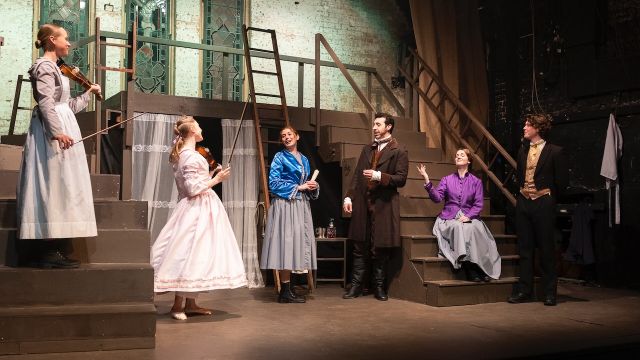By Charlotte Bronté. Adapted for stage by Ali Bendall. Director Ali Bendall. Genesian Theatre. 5 Oct – 10 Nov, 2024
Reviewed : 5 October, 2024*

Charlotte Bronté published Jane Eyre under the male pseudonym Currer Bell in England in 1847. In 1868 in faraway Australia, St John’s Church was opened in Kent Street Sydney. Over 150 years later they come together in this in this farewell production in the building that has been the home of the Genesian Theatre Company for 70 years.
That director Ali Bendall has a special affinity with both is evident in her sensitive adaptation of the novel … and her insightful directorial idea to highlight “all the unique characteristics” of the Genesian stage in this special, farewell performance.
Adaptations, especially of classics, need to be treated with respect and care. Respect for the story and the themes that have resonated with so many readers over such a long time; care that the characters lose none of the depth and dimension that have made them so loved … or so loathed. Care also that the setting and atmosphere so skilfully created in words by the author are sustained.
Ali Bendall has been completely true to Charlotte Bronté. Her clever use of Bronté’s original dialogue shapes the characters clearly, placing them firmly in their time and context. Equally clever is her modification of the author’s “Dear reader” to allow Jane to speak through the fourth wall ensuring Bronté’s irony, humour and wit are not lost on the audience.

Most importantly, as an actor and director, Bendall has “seen” the adaptation on the stage as she wrote. She has carefully considered time and place – and worked closely with Tom Fahy and lighting designer Cian Byrne to create the atmospheres Bronté described, as well as giving her space to move the action quickly and creatively. Stairs and ladders, balconies and hidden recesses, bare walls and stained-glass windows lit by fiery red or cool white take Jane from isolation in the haunted “red room’ at Gateshead Hall to the callous classrooms of Lowood Institution and the lofty levels of Thornfield Hall.
Devoid of flats and curtains, the old walls of the stage conjure the gothic atmosphere of Bronté’s story. Two long hessian drapes and lace curtains are the only added decoration, but Bendall uses them and the nooks and spaces below the stairs creatively. She hides Jane with a book under the stairs in one scene. Stools or red-covered books appear magically in others. Little Adele and Mrs Fairfax wonder at the contents of a “bôite” of gjfts in a curtained alcove under the balcony in a later scene.
The stairs and balcony – and a carefully planned lighting plot – are used effectively to move quickly and fluidly between scenes. Lowood is introduced by the cast, in pinafores and caps, standing as if in class on one set of stairs. Jane holds and comforts her friend Helen in her final moments on another.
Bendall uses innovative ideas to give the production a contemporary feel without losing context. For example, Jane’s eight years of schooling at Lowood are suggested by the cast performing stylised actions while declining French and Latin verbs or repeating biblical texts.
The costumes, too, suggest the time, but allow for ease of movement on the stairs and ladders. And there are nice little points of interest that appeal to those notice! The girls all wear the same basic costume of cream tops and skirts and black laced boots. Smocks or coats are added for specific scenes. Only the men, Mrs Fairfax and Adele wear traditional Victorian costumes.

The cast work with a sense of sustained energy, becoming the twenty-three people that are part of Jane’s story. Whether working in ensemble scenes or as specific characters, they are always in the moment, sometimes shining. Roslyn Hicks, for instance, is a very harsh and vindictive Mrs Reed. Karys Kennedy is firm yet understanding as Bessie. Neilson Brown is suitably loud and hard as Mr Brocklehurst and cunningly calculating as St John Rivers.
Kyra Belford-Thomas plays Jane with an energy that captures the tenacity that drove Jane to defy oppression and seek respect. Belford-Thomas moves easily on the stage, whether climbing stairs and ladders or pausing momentarily before moving into a new scene … or stopping briefly to make a quick, witty aside to the audience.
Her characterisation is excellent, moving Jane clearly from defiant ten-year-old, to studious teenager, restless teacher, warm governess and ardent lover. Her timing and control make special moments in the story memorable, as when she kneels for long minutes listening at Rochester’s feet, depicting in those minutes all the qualities that Rochester describes. Or when she struggles to be true to herself when leaving Thornfield Hall, or rejecting Rivers’ proposal.
Vincent Andriano is a moody, introverted Rochester whose moments of caring are cloaked by the dark secret he carries. Andriano’s height and presence compliment Belford-Thomas’s more diminutive stature making their scenes together additionally poignant, especially those where Adele (played with childlike joy by Julia Grace) and Mrs Fairfax (Jenny Jacobs) in the background suggest possible happiness to come.

Ali Bendall’s clear adaptation emphasises the wit and humour Charlotte Bronté’s novel. Her innovative directorial ideas and decisions make the story pertinent to contemporary audiences. They also give this enthusiastic cast the chance to work with a director who plans carefully and imaginatively and obviously instils confidence and conviction.
Ali Bendall’s Jane Eyre is a fitting and poignant farewell to the old church that has been Sydney’s Genesian Theatre for the past 70 years – and an optimistic promise of things to come in the company’s new home in Rozelle.
First published in Stage Whispers magazine
*Opening Night